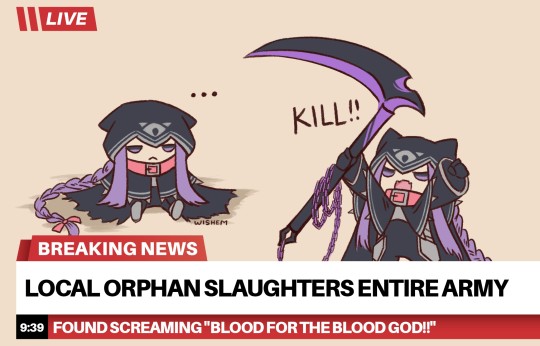Text
it's illya's birthday everyone clap or nobody gets out alive
3K notes
·
View notes
Text






CHILDE, SKIRK, & THE ABYSS WHALE
Genshin Impact Version 4.2 - Masquerade of the Guilty
1K notes
·
View notes
Text
Kabbalah in the Worldbuilding of Genshin Impact; Part 1: The Tree of Life, the Universe, and Everything
Written by Schwan (@abyssalschwan on twitter) and Sabre (trashcanlore, @paimoff on twitter)
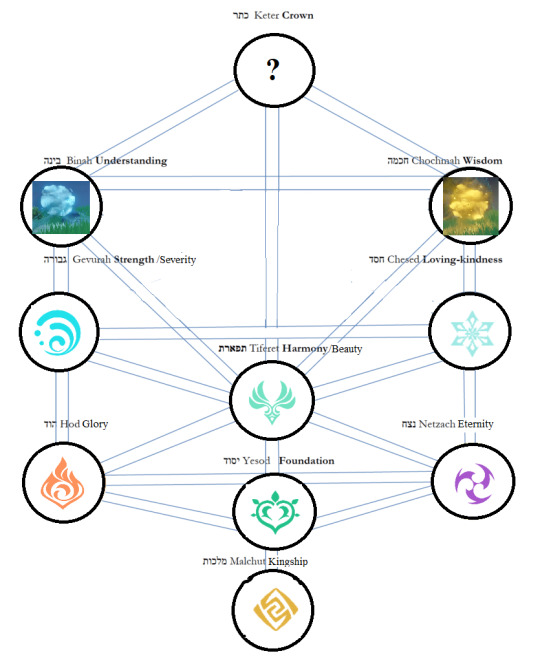
During the Sumeru Archon Quests, we learned that the Irminsul is a (real! (ish)) tree that grows upside down, seemingly underground, and that the roots of the tree are the Ley Lines, which extend throughout Teyvat and the Abyss. Irminsul stores all knowledge and memories in the world, and the Ley Lines are the mechanism by which the tree acquires this information. Ley Lines move elemental energy through Teyvat, which acts as both a storage medium for information but also a source power that can be utilized for combat, alchemy, an energy source (Azosite), etc.
The origin of the name Irminsul (unique to the Western localizations) in combination with the many names from Norse mythology associated with Khaenri'ah, suggest that the inspiration for Irminsul is Yggdrasil, the world tree and central axis of the cosmos in Norse mythology. Here we propose an additional inspiration for Irminsul and the associated worldbuilding and elemental system of Teyvat: The Kabbalistic Tree of Life. In this model, Teyvat’s elemental energy is comparable to the creative energy described by Kabbalah as the foundation for the creation of reality and the world. Specific attributes of elemental energy can be channeled by unique individuals in Teyvat and these attributes manifest as distinct elements, which can be directly compared to the 10 sefirot, or emanations, described in Kabbalistic literature.
What is Kabbalah?
Kabbalah (lit. received, tradition) is a school of thought originating in Jewish mysticism. In general, Kabbalah focuses on the relationship between the infinite (God) and the finite universe and how it was created. The goal of studying this mysticism can vary depending on the group studying and their motivations. Many of the esoteric and religious influences on Genshin lore and worldbuilding were influenced by Kabbalah, or vice versa. These include Gnosticism, Hermeticism, alchemy, Freemasonry, the occultist branches of Theosophy and Thelema (Golden Dawn), astrology, symbolic interpretation of the tarot (also specific to the Golden Dawn) and more [2]. In short, Kabbalah is everywhere. Additionally, its concepts are used as symbolism in several pieces of media that directly or indirectly inspired Genshin and other games in the Hoyoverse.
If you have frequented Genshin lore topics, you might have heard that one of the main sources of inspiration for it is Gnosticism. The problem is, Gnosticism is a bit vague or contradictory when it comes to how the world was created and how the whole existence thing works. At this current moment in the storyline of Genshin, we have very little information on the very beginning of existence in Teyvat. This information seems to be a crucial part of the “truth of the world” and appears to be purposefully hidden by powerful factions like Celestia. This entire theory was born out of trying to make sense of what little we know about the creation of Teyvat and comparing it to esoteric commentaries on the well known creation myth of the Torah (Old Testament). The “Biblical world structure” interpretation of Teyvat has been around since the early days of Genshin lore and with good reason; there are frequent mentions of the firmament, as well as the name Teyvat sounding very similar to the Biblical Hebrew word for ‘ark’ (although the grammar is a bit mangled). There are also several references to stories from the Bible in in-game texts, including Before Sun and Moon.
Kabbalah generally focuses on understanding and describing the process of how the world was created and the underlying principles of reality, as well as how spiritual practice can change that reality (either metaphorically or literally). To summarize something very complex, Kabbalah describes the “true nature of God,” which is equal with the entirety of existence, as something very vast and completely impossible to grasp. This incomprehensible infinity emits an “limitless light” that is the origin of all creation. Elemental energy (the ubiquitous source of everything in Teyvat) is often found compared to light, something we’ll discuss in more detail later. The “limitless light” of Kabbalah is way too powerful for existence to bear, much like how elemental energy is to normal, non-Vision having humans. That’s why this light needed to be “filtered” down. This happens through the process of creation, which passes the light through the spiritual attributes that form the Tree of Life, which is like a sort of diagram for how the universe came into being [3].
The Tree of Life
The tree of life and its 10+ nodes, known as sefirot, is one of the most well-known concepts from Kabbalah to make its way into popular culture. As mentioned previously, the tree has been used as rule-of-cool symbolism in anime such as Neon Genesis Evangelion and Fullmetal Alchemist, two pieces of media that likely are significant influences on Genshin (If you doubt that HYV loves NGE, play some Honkai). The sefirot are also depicted on the floor of the Schicksal HQ map in Honkai Impact 3rd, for some reason.
The sefirot and their organization and interactions with each other can be found depicted in many ways, such as the tree format that is the most popular, or a spiraling nested scheme that is really cool, or even very stylized, like the work of Robert Fludd.

Sefirot
Sefirot comes from the root word in Hebrew meaning “to count,” but you can also find it translated as “sphere” in some texts. The term originated in a book on Jewish mysticism called the Sefer Yetzirah, or “Book of Formation/Creation.” which describes the combination of the “sefirot of nothingness” and the 22 letters of the Hebrew alphabet as the foundation of reality (remember the hypostasis codenames?).
The Sefer HaBahir (lit. the book of brightness, 13th century France) introduces the idea that the sefirot are emanations of the divine. Interestingly, this book refers to the sefirot as ma’amarot (sayings), which builds on an important concept in classical Jewish philosophy – the idea that God spoke the world into existence. [We’ll get back to the Sefer Yetzirah and the role of language in creating the world in a subsequent part of this theory].
Historically, Kabbalah might have taken this rough concept from a very different school of thought: Pythagoreans or neo-Platonists. Briefly, the connection between the Pythagoreans and the Kabbalistic sefirot is that both groups considered the world as being made of numbers. This ties back into Genshin worldbuilding because of how much Platonism is related to Gnosticism. Something else to keep in mind is that Pythagoreans (who had a cool history that connected Egypt and Greece to the magic of ✨math✨ but also hey Genshin lore hello Deshret) were known to use lyres as their instrument of choice while making mathematical studies of music. More sus Venti lore for the collection? This is also interesting to consider in the context of Nahida, who is deeply connected to the Irminsul, and has animations that are reminiscent of computers.
Later in the 13th century, the Kabbalist Isaac the Blind would 'canonize' the list of sefirot (there’s still some variation to this day) and organize them into a sequence that would become the basis for the famous Tree of Life structure. His writings described the sefirot as attributes of the divine and their role in the creation of the world. In his model, the sefirot originated from lights that emerged from a primordial soup of potential, and these sefirot/lights would then ‘flow’ and emanate into each other. His student, Azriel of Gerona, expanded on this with a neo-Platonic lens and introduced the concept of the Ein Sof, the infinite nothingness that cannot be comprehended and is the origin of everything. In this model, being flows from an infinite resource of potential, which the divine can utilize through the framework of the sefirot, eventually creating the world [4]. In simple terms, the Ein Sof, which contains everything, emits a primordial light that then differentiates into the sefirot. In our Genshin analogy, this primordial light would be like extremely pure elemental energy that differentiates into elements, like light passing through a prism.
Moses ben Jacob Cordovero, an important figure in the development of Kabbalah, described the process of the sefirot differentiating with the analogy of light shining through a stained glass window:
Imagine a ray of sunlight shining through a stained-glass window of ten different colors. The sunlight possesses no color at all but appears to change hue as it passes through the window. The light has not essentially changed though it seems so to the viewer. Just so with the sephirot. The light that clothes itself in the vessels of the sephirot is the essence, like the ray of sunlight. That essence does not change color at all, neither judgment nor compassion, neither right nor left. Yet by emanating through the sephirot -- the variegated stained glass -- judgment or compassion prevails. (Pardes Rimmonim by Moses Cordovero, translated in Essential Kabbalah by Daniel Matt)
Cordovero considered the sefirot to be completely independent of each other, but the later Lurianic school of Kabbalah (we’ll get into them more in later parts) considered the sefirot to be constantly dynamically interacting with each other and also assigned them personas.
Sefirot and the Genshin Elemental System
Achievement grinders amongst us may recall the descriptions of the namecards you get upon completing the Elemental Specialist achievement series:
Achievement: Colors of the Rainbow: Light can refract into countless colors, but people stop at seven because they're too lazy to count. Perhaps the elements are like that, too.
Achievement: Seven Lights: Anyone can play a tune that belongs just to them, and like the dew under grass, can reflect the seven lights of heaven.
Another example of the elements being compared to light is the Latin text found on the magic circles on the door of Mona’s future house in Mondstadt and generated by the hypostases during their missile attacks. The text reads:
Ex culmine lucis in magno elementorum, which translates to "From the peak of light, to greatness of the elements."
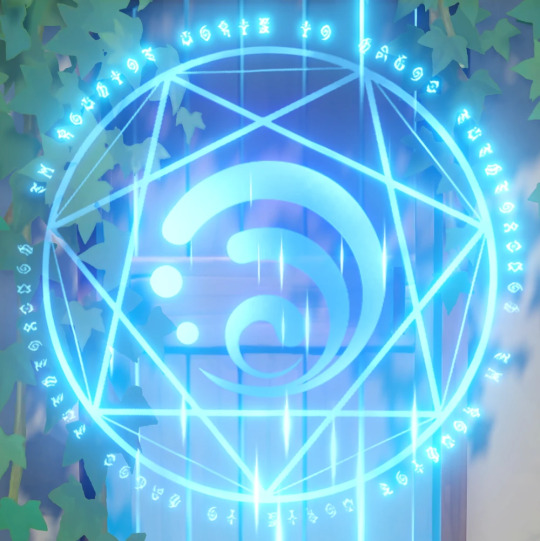
It’s interesting to see this text appearing in association with the hypostases since they are described as “life forms which have completely abandoned their former appearance and biological structure, making them able to reach the highest level of elemental purity. They are ultra-compact structures with a high mass, and are the highest forms of elemental structures.” The hypostasis code names are also all Hebrew letters, as mentioned earlier.
Mona’s astrolabe during the Unreconciled Stars event features a similar text:
Ex culmine locis in magno elementorum; Lux se effundat in mentes dei, which translates to "From the peak of light, to the greatness of the elements; May light pour out, into the minds of god."
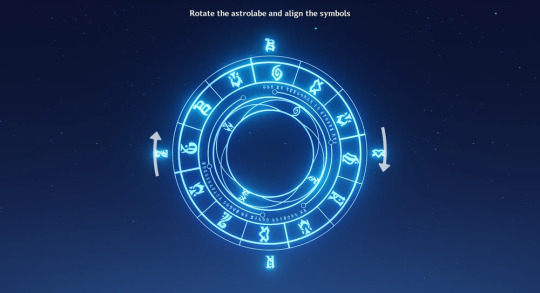
The Abyss Lector catalysts contain a text that mirrors these two examples:
Ex culmine lucis in mango obscuritas. Lux se effundat in mentes abysso, or “From the peak of light, to the greatness of darkness. May light pour out into the minds of the abyss.”
The Genshin elements are also described as flowing. For example, a loading screen tip specifically describes the Ley Lines as “A mysterious network that links the whole world together, within which flow the elements.” The Silver Twig description states: "All knowledge, memory, and experience flow through this giant tree, just like a stream flows into a river, the river joins a sea, the sea turns into clouds, and the clouds rain onto the ground — just like life itself."
The 10 (sometimes 11) sefirot are:
Keter: Crown (this one is even more symbolic that the rest, is described as “the most hidden of all hidden things" in the Zohar, represent things that are above the mind’s comprehension and the very beginning of the process of turning potential into reality)
Chokhmah: Wisdom
Binah: Understanding/Reasoning
(Da’at: Knowledge, as a fusion of Chokhmah and Binah)
Chesed: Loving Kindness or Mercy
Gevurah: Strength/Severity, (sometimes Din, Judgement, or Pachad, Fear)
Tiferet: Beauty/Harmony, is associated with balance of the Tree of Life
Netzach: Eternity/Endurance
Hod: Splendor/Glory
Yesod: Foundation (as in, foundation of reality)
Malkhut: Kingdom/Sovereignty
You’ve probably noticed by now that while we are claiming that the concept of the sefirot applies to the elemental system in Genshin, there are 10 sefirot and only 7 elements (for now). Fortunately for us, the Kabbalists love metaphors and categories. In addition to the sefirot representing the procedure used to ‘emanate’ and create the world, there are other methods of interpretation that further subdivide and rank the sefirot. For example, one metaphorical interpretation of the Tree of Life assigns each of the sefirot to a part of the human body.
In the Chassidist Kabbalist tradition of interpreting the tree, the 10 sefirot are divided into two categories: Intellect (Keter, Binah, Chokhmah) and Emotions (they’re actually more like character traits), which contains the remaining seven. These categories are meant to parallel how the soul is also divided into the intellect and emotional components. The first three sefirot are also referred to as the “three mothers,” because they are the source of the lower seven [5].
Having a group of seven sefirot is very convenient for comparing their traits to the elements and their ideals, but what about the role of the higher three in Genshin worldbuilding? This next section requires a bit more conjecture than some other comparisons here.
The source of all elemental energy in Teyvat, whatever that actually is, could be compared to Keter (crown), the most hidden and incomprehensible of the sefirot. (Big stretch, but think of the crowns over the Irminsul trees in domains.)
Next, we have the Ley Lines, which contain dreams and memories (these are basically the same in Teyvat, see Dream Solvent description), and these can be compared to Binah (understanding/reasoning) and Chokhmah (wisdom). During the Sumeru Archon Quest, Rukkhadevata says that dreams are the source of the wisdom she upheld as her ideal. Memories play an important role in discerning the truth of the world, as the traveler has now found themselves to be the only person to remember certain people/events, and has been told to trust their memories rather than what they can see.
Comparison of the 'Lower' Sefirot to the Genshin Elements and Their Ideals
Chesed (loving-kindness); Cryo (unknown, theorized to be love)
The Cryo Archon’s ideal is theorized to be love, as it’s the only characteristic mentioned in relation to her in the Travail trailer. Wanderer’s voiceline about her directly mentions love and describes her as being kind and benevolent, while Childe describes her as extremely gentle. These are the characteristics of Chesed, which represents the trait of completely selfless love: the all forgiving, all giving love of a god towards their creations. When it comes to the Cryo element itself, two things are worth mentioning: one is the way that all of Snezhnaya is perpetually covered in snow, as if this were the (ironic) physical expression of the Tsaritsa’s love blanketing them. The second is the promise of a world-encompassing snowstorm that will envelop everything as the Fatui advance on their war against Celestia. Although it’s hard to find one absolute constant in Vision granting stories, it’s notable that most Cryo users got their Vision at a moment when they had to selflessly be there for others (Diona, Chongyun, Mika), or after a decisive moment where they put aside their personal comfort for an ideal that would result in benefit for others (Kaeya, Eula, Layla).
Gevurah (Severity); Hydro (Justice)
Gevurah is associated with divine judgment, the kind that punishes humanity and causes world-altering catastrophes like the flood or the expulsion of Adam and Eve from the Garden of Eden. The Hydro Archon organizing her nation around a Court that attempts to judge both deities and humans parallels this. In a more positive sense, Gevurah is also related to moral judgment that allows one to tell good from evil Likewise, Hydro in-game is often associated with purity and separation of clean and unclean matter. When it comes to Hydro Vision wielders, one common characteristic is that they all live by a personal ethical code, and their commitment to it is what granted them their Vision.
Tiferet (Beauty/Harmony); Anemo (Freedom)
Tiferet balances the other sefirot on the tree and has direct connections to almost all of them (except for Malkut). Similarly, Anemo can facilitate many elemental reactions via its Swirl reaction. In our opinion, something almost all the Anemo characters share is that their moment of receiving a Vision coincides with a moment of balance and harmony with themselves or their environment. See Jean and Kazuha’s Vision stories and the cutscene where Scaramouche/Wanderer gets his Vision. As an aside, comparing harmony to Anemo is funny because Venti is a bard and harmony is also a musical term: in music theory, harmony is the way we analyze the interactions between different voices that can be heard at the same time.
Netzach (Eternity); Electro (Eternity)
The quality of “Eternity” in Netzach is related to victory against enemies, referring to eternity as being the most powerful combatant remaining among defeated adversaries. Likewise, in Genshin the story of the Electro Archon features many battles during the Archon War where Ei and Makoto ended up victorious. As for Electro users tend to have their Vision granted at a moment when their ambition “defeated” the obstacles of reality, as was the case with Fischl, Kuki and Lisa. Cyno’s Vision story makes sense when you compare it to the illumination of Buddha during meditation, and how this was victory over the temptation of the demon Mara.
Hod (Glory); Pyro (War)
Natlan and its Pyro Archon are possibly the most mysterious of all the regions, so we can only speculate. We know that the Pyro Archon is called the God of War, and that the Pyro Gemstone mentions battles, pilgrimages and truth. The sefira of Hod, translated as Glory or Splendor, is linked to being able to connect with God and therefore also associated with prophecy (as in the way a human can carry a message from God). In the Travail trailer, the Pyro Archon tells the traveler that “the rules of war are woven in the womb.” It's also theorized Natlan will be based on Mexica culture (where sacrifice of both enemies and self sacrifice was a way to connect with the gods) and via Iansan's name, the Caribbean diaspora version of Yoruba religion (where many rites involve the gods making themselves present in the material world).
Yesod (Foundation); Dendro (Wisdom)
Back when we started to think about this theory during version 2.8, we decided on Yesod largely via process of elimination. One piece of our rationale was that in the Jewish tradition, each of the lower seven sefirot are used to represent a primary personality trait of seven archetypal figures in the Torah. The person related to Yesod is Joseph, who is well known for his prophetic dreams, and because of the events of the Golden Apple Archipelago, we decided that was close enough. However, the 3.x version confirmed that a) Irminsul did actually exist, b) Dendro as an element has a deep relationship with the tree, with the Dendro Archon acting as its avatar, c) the ideal of wisdom as both Dendro Archons interpreted it has a lot to do with dreams, and d) Irminsul and the Ley Lines act as the foundation for how reality is perceived in Teyvat. Yesod is also associated with biological life, as it represents the reproductive organs in the human body scheme of the sefirot.
Malkut (Kingship); Geo (Contracts)
Malkut is associated with the connection between the spiritual "above" of the Tree of Life and the concepts it contains, and the "below" of the material world, where these concepts manifest into material reality. For this reason, Malkut is associated with the earth [6]. In many Geo item descriptions, like the Geo Hypostasis drop or Albedo's elemental skill, the motif of geo trying to reach the sky is a constant. From a religious POV, the relationship between the divine and humans living in the material world has also been one of "covenants," or "pacts", in a similar way to how the Geo Archon is the God of Contracts. Furthermore, contracts are the basis to have a working state (government), and a kingdom is one of the first forms of a state. Malkut also being related to earth and everything material parallels how Geo is an element that works in making constructs. Geo Vision users are likewise involved in making or maintaining structures, like the Knights of Favonius is for Noelle, or the tradition of alchemy is to Albedo, as well as opera to Yunjin and in a way, even the Oni identity for Itto.
The Origin of Evil and Why Irminsul is Upside Down
Along with Kabbalah's very detailed explanation of how the world and all its positive attributes was created, there is also an explanation of how evil came to be. The analogy used in this explanation is vessels being filled with a liquid, which refers to the primordial light from Ein Sof described earlier, also referred to as "Limitless Light." After filling the vessel, the liquid then overflows into more vessels beneath the original. The higher vessels have the purest form of this liquid, and the more it’s poured "down", the more diluted it is. When the upper "vessels” of the higher sefirot were filled everything was fine, but when the vessel of Judgement (Gevurah) was being filled, the power of the Limitless Light overflowed and the vessel broke. In other words, Judgement or Severity got out of control, and this caused a catastrophe. Eventually creation continued, but (at least in the dominant, Lurianic Kabbalah tradition, as there are many interpretations) the vessel of Judgement remained broken [7].
One could compare this perpetual dysfunction of Gevurah to the mismanagement of Teyvat by the Heavenly Principles. The Heavenly Principles, who seem to be in charge of keeping the "good" of life in Teyvat separate from the dangers of the "evil" abyss, don't seem to be in control enough to keep their efforts from destroying the lives of innocents or even entire civilizations.
Even though the Judgement of God is severe, Kabbalists still consider it part of divine nature, and therefore inherently good. So what does this imbalance in Gevurah have to do with the origin of evil?
After the vessel that contained the overflowing Judgement broke, the shards of the broken vessel fell beyond the "space" of creation, into the void left behind during the creation of the world. These "shards'' are also referred to as "husks" (Qlippoth, lit. husks or shells) and become the origin of evil in the form of demonic beings [8]. Sounds familiar? We actually have an enemy with this name in-game; the "shadowy husks" (the CN name for these enemies literally translates to "empty shell"). In Kabbalah, the "husks" and the demons born from them form a "dark" mirror to the Tree of Life (it's sometimes called Tree of Death in Western esotericism, but it's not a term original to Jewish Kabbalah).
However, unlike the very well defined 10 sefirot of the Tree of Life, Kabbalists don't seem to agree about the identities of the Qlippoth that form the "left hand side", or as it is called in Hebrew, the Sitra Achra. Some names for these demons are consistent, such as Lilith, Samael, and Asmodeus, who make a sort of "mother, father, son" trio. As for the rest, and also the many other demons that were born from them, scholars generally agree that Kabbalists blended traditions from nearby cultures depending on where they lived, leading to Arabic, Spanish and Germanic legends mixing into the Jewish tradition [9]. There's a strong possibility Hoyoverse did something similar and filled in the missing names with the names of the demons of the Ars Goetia.
Theory/speculation time: The demons of the Sitra Achra are none other than the Archons that rule the modern Teyvat, including both the ones defeated during the Archon War and the current Archons that rule the nations.
Besides the concept of the mirrored Tree and associated demons, another piece of evidence is the similarities between the role of the Gnoses (and the power they give the Archons) and the nature of the Qlippoth. When the shards of the broken vessel of Gevurah fell into the void, they still retained some "sparks" of the Divine Light, like embers that jump out of a fire. But just like embers, these sparks couldn't sustain themselves when separated from the Limitless Light inside the void. That's why the demon-like Qlippoth have to prey on the living beings of the material world who are more directly descended from the divine, so they can "steal" some of their life energy [10].
The Archons in Genshin require a similar system. In the Flower of Paradise Lost artifact lore, the Goddess of Flowers explained to Deshret and Rukkhadevata that when the Seelie race was disgraced, they lost their connection to Heaven and, literally, their power of "enlightenment". After that, the Archon War was started with the promise of each winning god being granted a Gnosis that would give them exceptional power. Both Nahida and Venti have described the Gnoses as being a very advanced tool that concentrates elemental energy: it channels it, but it doesn't create it. Archons have inherent powers related to their nature, but when it comes to controlling elemental energy, they aren't creators but channelers of it, just at a much bigger proportion than humans who have Visions.
So now we have our explanation as to why the Irminsul is upside down. Or rather, it's the residents of Teyvat who are standing on the opposite side: the Teyvat we know today is the Teyvat of the Sitra Achra, ruled by demons.
However, this doesn't mean Teyvat is condemned. Just as Traveler has slowly been setting the chaos of elemental energy back into order (by, for example, returning the elemental Oculi to the Statue of the Seven, among many other things), so too is there a concept in Kabbalah describing the importance of righting the wrongs of the universe so that the sefirot are stable and creation is in harmony with the divine. This is called Tikkun Olam, or the repairing of the world. Stay tuned for part 2 where we go into wayyyyy more detail about what this means for the Traveler's journey through Teyvat!
References:
https://www.chabad.org/library/article_cdo/aid/170308/jewish/What-is-Kabbalah.htm
https://en.wikipedia.org/wiki/Hermetic_Qabalah
Kabbalah - Origins of the Sefirot and Tree of Life - Isaac the Blind Saggi Nehor & Azriel of Gerona
Mystical Concepts in Chassidism - Schochct, Jacob Immanuel, chapter 2
Mystical Concepts in Chassidism - Schochct, Jacob Immanuel pg 66-67, Tanya ch. 3
Rebbe Nachman of Breslov, Likutey Moharan I, 12:1 via Wikipedia
https://theomagica.com/on-the-nature-of-the-qlippoth
http://www.digital-brilliance.com/themes/evil.php
https://www.jewishvirtuallibrary.org/demons-and-demonology
Evil in Early Kabbalah - Emanations of the Left Hand Side - Origins of the Qliphoth / Klippot
381 notes
·
View notes
Text



ALBEDO ⟡ Genshin Concert Promotional Video
2K notes
·
View notes
Text



New Genya art for kny pop-up shop!
678 notes
·
View notes
Text

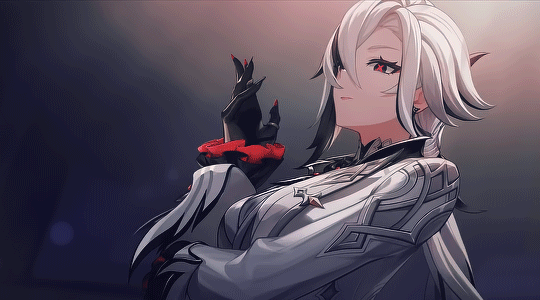
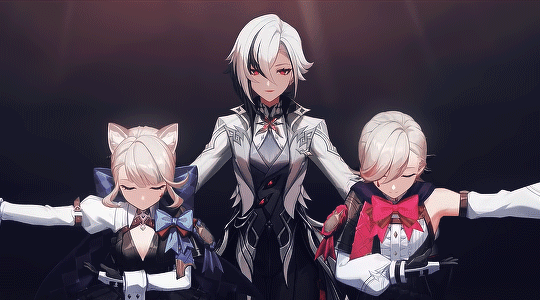
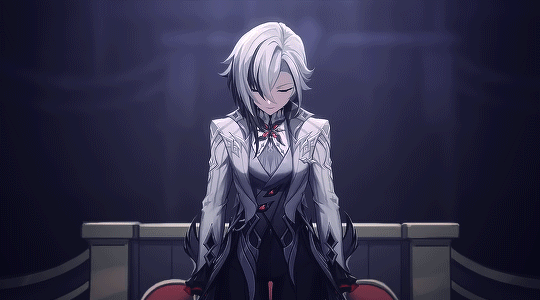
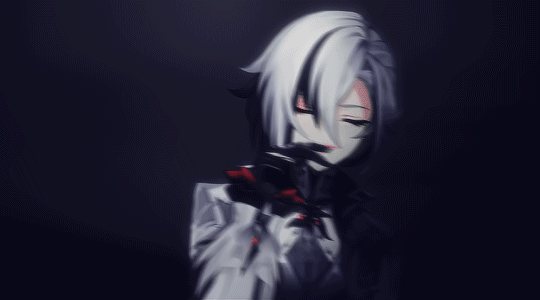
Very fun. But it's not enough. Let me make something clear: you think of yourselves as "magicians", but when you're on the stage you're first and foremost actors. Good actors hone their craft to mesmerize the whole crowd.
10K notes
·
View notes
Text
First rule of reincarnation is to have insane sex with the guy who killed you last time
59K notes
·
View notes
Text
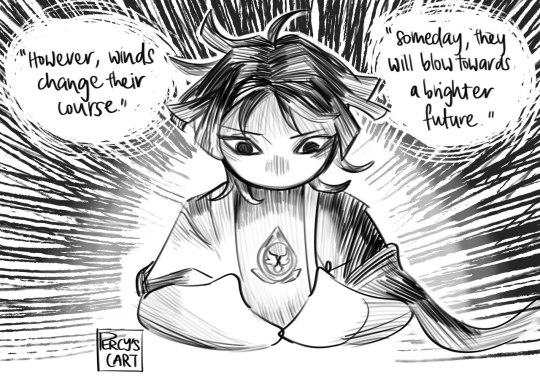
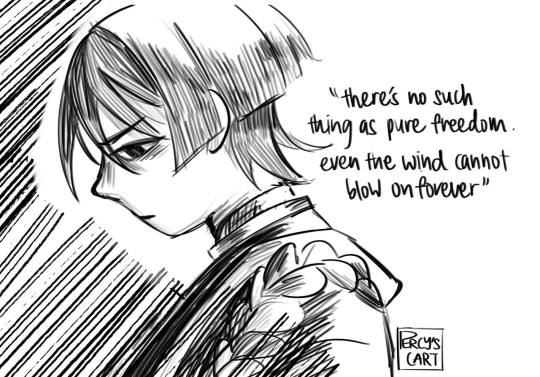


freedom?
(cookies for those who can guess correctly who said these lines and when 🍪)
2K notes
·
View notes
Note
Hi, sorry to be a bother but do you have a tag for posts explaining how you draw/colour? I think I remember seeing one of your posts on shading/colouring technique and I can’t seem to find it, your art is so pretty and the way you use colour makes me speechless every time.

thank you both!! I usually have it under "tutorial" tag, but I'll repost this one and add onto it :>



hopefully that helps!!
I've mostly been eyeballing colors nowadays but layer modes can also help you pop your saturation or lighting/shading :>
just be sure to pay attention to how bright your colors are overall, the method I use to make the colors feel vibrant is to pair it next to a more muted color/one that contrasts it on the color wheel
515 notes
·
View notes
Text

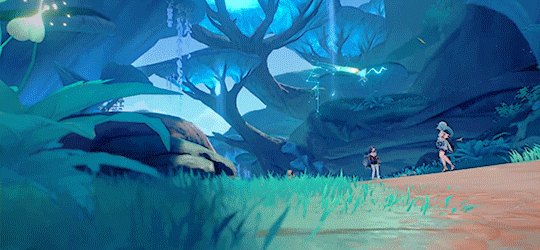
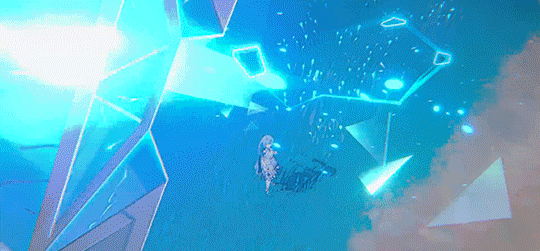



Genshin Impact Version 3.6 ✩ A Parade of Providence
1K notes
·
View notes
Text
since apparently this is controversial, reblog with your country in the tags and whether or not you think noodles and pasta are the same thing
56K notes
·
View notes
Photo

Genshin Impact Characters
BREAKING: Paimon still hungry, still looking for treasure.
Albedo +6
Zhongli -1
Childe -1
Xiao +1
Kaeya -2
Diluc
Arataki Itto +16
Venti -4
Scaramouche +16
Kaedehara Kazuha +1
Thoma +17
Aether -3
Tighnari
Kamisato Ayato
Yae Miko +25
Lumine -8
Gorou +8
Raiden Shogun +2
Hu Tao -7
Pantalone
Cyno
Shenhe
Ganyu -8
Paimon -8
Il Dottore
Shikanoin Heizou
Arlecchino
Beidou -14
Klee -10
Ningguang -13
Chongyun -18
Eula -2
Kujou Sara +15
Pierro
Mona -9
Yelan
Keqing -16
Il Capitano
Xingqiu -21
Qiqi -11
Xinyan -3
Dainsleif -15
Sangonomiya Kokomi -1
Rosaria -7
Bennett -23
Yanfei -11
Columbina
Sandrone
Alhaitham
Yoimiya -31
The number in italics indicates how many spots a name moved up or down from the previous year. Bolded names weren’t on the list last year.
4K notes
·
View notes
Text
if you're on trial for a nondescript crime and the character in your pfp is your lawyer, is your ass going to jail?
#yes my girl has committed several crimes against humanity#and is wanted in multiple countries#tamamo no mae
39K notes
·
View notes
Text
Omg, you’re from Italy? I loved jojo part 5
44K notes
·
View notes



